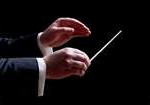A series looking at the art of the choral conductor.
As remarked in the previous post, the conductor’s job is made difficult by the fact that, of all the performers, you are the only one unable to make a sound. All those exhortations you’ve given in rehearsals, all those encouragements you’ve uttered, all those points you’ve flagged up as looming up ahead whilst in mid-phrase – you can’t do any of that in performance.
 So, what have you got as a conductor ?
So, what have you got as a conductor ?
Your hands are the most obvious tools: at their most functional, the right-hand articulates the beat, the left-hand gestures to bring people in. The left-hand has an additional role, in also crafting the nature of the sound. But the expression comes in the beat as well, in the manner in which the right hand beats the time. Depending on how you give the beat with the right hand, the resultant sound will be different: a brisk beat will engender a crisp sound in the performers, a gentle beat will elicit a more languid sound and so on. The left hand adds an additional dimension to the shaping of the sound, and can also be used to guide the unfolding phrase, leading the singers through a sustained phrase, or drawing them together for sudden silences; opening wide for greater forte or closing gently for a delicate pianissimo.
The conductor’s eyes are a particularly effective tool of communication; you use them to glance at a voice-part to alert them to the fact that they are coming in shortly, and look directly at performers when they come in; they can also express the nature of the sound you’re expecting – a fierce glare for a dramatic moment, half-closed eyes for a moment of profound beauty, and so on. I recall once playing the piano in a contemporary music ensemble, and waiting to come in; at the moment I was due to play, the conductor’s gaze struck me like a blow and the conducting hand shot out like a rocket towards me: I played the chord with perhaps more percussive force than in rehearsal, which was just the effect he wanted in the performance.
The conductor’s face is also important, and is perhaps the least voluntarily controlled yet most responsive aspect; as you are moved by what you are conducting, so your face can’t help but respond to the emotional nature of the moment.
Here’s an example of Leonard Bernstein conducting with nothing but his eyebrows, almost: from 3′ 46” onwards, in the encore, he gives the orchestra complete freedom, and gestures only with his face: and how exuberantly the orchestra responds.
You might not be able to make a sound, as a conductor, but you can certainly articulate, through your eyes, your hands and your face, what sound you want everyone else to be making!
In the next post, I’ll be looking at establishing a rapport with the choir in those early rehearsals.
